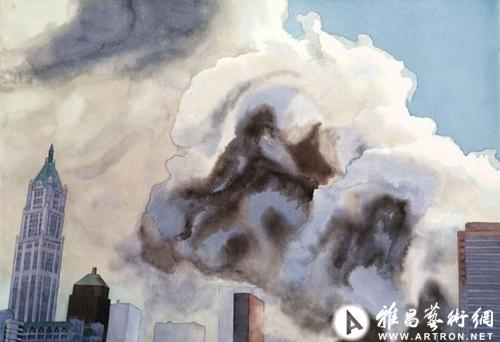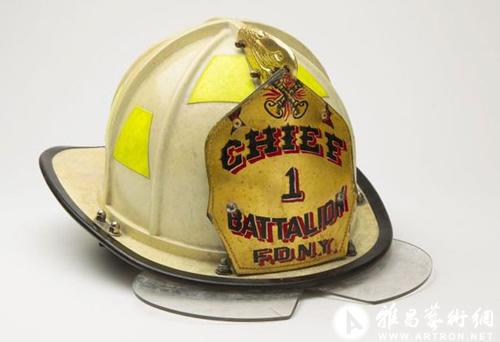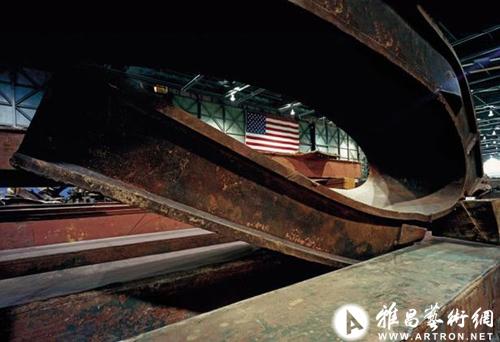编制机构:雅昌艺术市场监测中心(AMMA)

City of ruins: artist Todd Stone's painting of the 9/11 attacks, just one of the pieces of art inspired by the events
Immediately after the collapse of the World Trade Centre towers some survivors reported an unexpected effect. So dense was the cloud of dust that it not only blocked out the light but most of the sound too. Suddenly everything went strangely quiet as the debris muffled the screams and the sirens. And if you were looking for an image of the impact of 9/11 on the arts, that surreal lull – a temporary vacancy in what you could see and hear – would do as well as anything. The story of the arts and 9/ll has largely been a story told in negatives – of inhibitions and avoidance and empty spaces. As the novelist Frédéric Beigbeder wrote: "Since September 11 2001, reality has not only outstripped fiction, it's destroying it. It's impossible to write about this subject, and yet impossible to write about anything else." He had a go anyway and the resulting novel, Windows on the World, won this newspaper's Foreign Fiction Prize in 2005. But in imagining his way into the interior of one of those falling buildings he had the field pretty much all to himself. The really notable thing about the art of 9/11 is how little there is of it, even ten years on.

Image of 9/11 from the touring '9/11Museum'
It's not easy to say whether this should count as a failure of nerve or a triumph of decorum, but there's probably a bit of both in the mix. In the immediate aftermath of the attacks there was a widespread feeling that it was a time for sober documentation and not invention. Imagination wasn't accredited to pass behind the emergency tape. Far more urgent business was taking place, of commemoration and consolation. And while it was exceptionally easy to make bad art in the days following the attacks – art that waved a flag or simply restated comforting truisms – it remained hard to do anything of greater subtlety for a very long time. Creative works could plaster the wound but not probe it. That forensic task was largely left to non-fiction, which has flourished in the ten years since 9/11, in a gold-rush of belated explanation.

'Memory Remains' at the Imperial War Museum
One of the problems for artists was that art – or at least artfulness – had itself become suspect. The photographer Francesc Torres (whose remarkable photographs of 9/11 debris are on show at the Imperial War Museum) writes of his obsession, at the start of his project, with maintaining the balance between documentation and composition.
The recent history of visual art meant that twisted metal and distressed surfaces had already been incorporated into the language of art; Torres felt he had to strive to prevent mere beauty from overwhelming his images. And while aesthetics narrowed the possibilities on one side, the fear of exploitation blocked off other approaches, too. As a critic wrote disapprovingly of the 2010 film Remember Me (one of the very few mainstream Hollywood films so far to enlist 9/11 as a plot device), "borrowing from the enormous merely to entertain" was never going to go down well. Even those films that dedicated themselves to a respectful recreation of real events – such as Oliver Stone's World Trade Center and, much more successfully, Paul Greengrass's United 93 – had difficulty finding an audience. On television, meanwhile, you had only symptoms of trauma, the ugliest of them being 24, an apologia for torture which may well have helped to encourage the real thing.
Other forms took more liberties. One of the cultural first responders was the playwright Neil LaBute, never a writer nervous about social sensitivities. His play The Mercy Seat was first performed on 18 December, only three months after the attacks, and took the risk of bringing ignoble motives into proximity with that sanctified catastrophe – with the story of a man who should have been in the towers but was spending the morning with a mistress instead, and sees in the disaster an opportunity to shrug off an unwanted life without consequences or explanation. A New York writer called Leslie Bramm was even more audacious (or impertinent), writing a short play called Lovers Leapt, which imagined the final fall of the couple who jumped hand in hand from one of the buildings. But again they were almost alone in tackling the matter directly. Even now, writers prefer the security of numbers. "Individually the writers felt the subject was too big for them to take on," Rupert Goold said recently about Decade, a portfolio theatrical piece, which opens this week. And it isn't hard to understand why writers should be so skittish either: Alexi Kaye Campbell's new play The Faith Machine sets its first scene in New York on "a sunny September morning", and concludes it with the tremendous roar of a low-flying jet. Ten years on and it still feels like a slow pan to a lifebelt marked SS Titanic.
Novels have proved a little more daring about the event. Don DeLillo's Falling Man actually begins in that suspended moment immediately after the destruction: "It was not a street anymore but a world, a time and space of falling ash and near night." And other New York novelists (Jonathan Safran Foer in Extremely Loud and Incredibly Close and Jay McInerney in The Good Life) also seemed to feel licensed by their proximity to the disaster to address it square on – though they mostly concerned themselves with the aftermath rather than the event itself. In that limited sense there has been a rich harvest of 9/11 books – as novelists and writers responded to the American response – in novels about extremist Islam and war, and a new kind of neurosis about public safety. Ian McEwan's Saturday, Mohsin Hamid's The Reluctant Fundamentalist, Joseph O' Neill's Netherland and John Updike's The Terrorist are not 9/11 novels in any straightforward way – but, like countless other books, they've been marked by the pressure wave of those explosions. Even the bestseller lists betrayed the impact: Robert Harris's Pompeii was set in AD79 but the success of his account of a wealthy imperial society dumbfounded by catastrophe had its origins in the volcanic clouds of dust that barrelled down the streets of lower Manhattan in 2001.
It's almost certainly too early for masterpieces though. Perhaps Amy Waldman's The Submission, about what follows when a Muslim wins the competition to design a Ground Zero memorial, will be the first really successful 9/11 book, as some early reviewers have already claimed. But if so, it will have to take liberties with the raw material that so far have been inhibited by respect and piety. Indeed, you could make an argument that the only truly successful works of art to date have been tangential or completely accidental, short-circuiting the anxieties of their creators.
Think of the undercurrent of sadness and mortality that ran through James Marsh's film Man on Wire, about the French funambulist who walked between the two towers in 1974 ("What a beautiful death", its subject says at one point, "to die in the exercise of your passion," a line Marsh daringly cut against an image of an airliner over a city). Or think of the eerie amateur footage of migrating birds caught in the twin beams of The Tribute in Light, the Municipal Art Society's commemorative installation at Ground Zero – whirling like bits of paper (or lost souls) high over the streets of Manhattan. Contemporary artists haven't even come close to that unpredicted collaboration between nature and tasteful civic piety.
Patience is all we need though. Tolstoy wrote War and Peace 60 years after the cataclysmic events it depicted and, while we won't necessarily have to wait as long for the 9/11's masterworks, we've only just acquired sufficient distance from the event to be able to take risks with the subject and reshape it into different forms. The dust is at last beginning to settle – and the normal noise of a culture will return to fill that space.
责任编辑:张天宇
推荐关键字:9/11 September 11 World Trade Centre
注:本站上发表的所有内容,均为原作者的观点,不代表雅昌艺术网的立场,也不代表雅昌艺术网的价值判断。

网友评论仅供其表达个人看法,并不表明本站同意其观点或证实其描述。